#1 july 1923
Explore tagged Tumblr posts
Text
Exactly one hundred years ago, the Tanomah Massacre took place, say the Houthis. Indeed, this happened, says the expert
In North Yemen, the Houthis have been ruling for eight years, a curious mix of monarchy and papacy, topped with a hint of Guevara. Today they commemorate the Tanomah massacre. Now an idyllic town high in the Saudi mountains, a century ago a Saudi militia slaughtered thousands of Yemeni pilgrims there. Often used in propaganda, yet nonetheless the truth. Tanomah is located in the southwest of…

View On WordPress
0 notes
Text


July 1, 1925 Journals of Anais Nin 1923-1927 [volume 3]
#anais nin#literature#july#july 1#words#quotes#academia#dark academia#quote#lit#books#books and libraries#self care#reading#quote of the day#self love#bookworm#book quotes#prose#booklr#bibliophile#excerpt#light academia#dreams
432 notes
·
View notes
Text


Band of Brothers Birthdays
January
1 John S. Zielinski Jr. (b. 1925)
21 Richard D. “Dick” Winters (b. 1918)
26 Herbert M. Sobel (b. 1912)
30 Clifford Carwood "Lip" Lipton (b. 1920)
31 Warren H. “Skip” Muck (b. 1922) & Robert B. Brewer (b. 1924)
February
8 Clarence R. Hester (b. 1916)
18 Thomas A. Peacock (b. 1920)
23 Lester A. “Les” Hashey (b. 1925)
March
1 Charles E. “Chuck” Grant (b. 1922)
2 Colonel Robert L. “Bob” Strayer (b. 1910)
4 Wayne “Skinny” Sisk (b. 1922)
10 Frank J. Perconte (b. 1917)
13 Darrell C. “Shifty” Powers (b. 1923)
14 Joseph J. “Joe” Toye (b. 1919)
24 John D. “Cowboy” Halls (b. 1922)
26 George Lavenson (b. 1917) & George H. Smith Jr. (1922)
27 Gerald J. Loraine (b. 1913)
April
3 Colonel Robert F. “Bob” Sink (b. 1905) & Patrick S. “Patty” O’Keefe (b. 1926)
5 John T. “Johnny” Julian (b. 1924)
10 Renée B. E. Lemaire (b. 1914)
11 James W. Miller (b. 1924)
15 Walter S. “Smokey” Gordon Jr. (b. 1920)
20 Ronald C. “Sparky” Speirs (b. 1920)
23 Alton M. More (b. 1920)
27 Earl E. “One Lung” McClung (b. 1923) & Henry S. “Hank” Jones Jr. (b. 1924)
28 William J. “Wild Bill” Guarnere (b. 1923)
May
12 John W. “Johnny” Martin (b. 1922)
16 Edward J. “Babe” Heffron (b. 1923)
17 Joseph D. “Joe” Liebgott (b. 1915)
19 Norman S. Dike Jr. (b. 1918) & Cleveland O. Petty (b. 1924)
25 Albert L. "Al" Mampre (b. 1922)
June
2 David K. "Web" Webster (b. 1922)
6 Augusta M. Chiwy ("Anna") (b. 1921)
13 Edward D. Shames (b. 1922)
17 George Luz (b. 1921)
18 Roy W. Cobb (b. 1914)
23 Frederick T. “Moose” Heyliger (b. 1916)
25 Albert Blithe (b. 1923)
28 Donald B. "Hoob" Hoobler (b. 1922)
July
2 Gen. Anthony C. "Nuts" McAuliffe (b. 1898)
7 Francis J. “Frank” Mellet (b. 1920)
8 Thomas Meehan III (b. 1921)
9 John A. Janovec (b. 1925)
10 Robert E. “Popeye” Wynn (b. 1921)
16 William S. Evans (b. 1910)
20 James H. “Moe” Alley Jr. (b. 1922)
23 Burton P. “Pat” Christenson (b. 1922)
29 Eugene E. Jackson (b. 1922)
31 Donald G. "Don" Malarkey (b. 1921)
August
3 Edward J. “Ed” Tipper (b. 1921)
10 Allen E. Vest (b. 1924)
15 Kenneth J. Webb (b. 1920)
18 Jack E. Foley (b. 1922)
26 Floyd M. “Tab” Talbert (b. 1923) & General Maxwell D. Taylor (b. 1901)
29 Joseph A. Lesniewski (b. 1920)
31 Alex M. Penkala Jr. (b. 1924)
September
3 William H. Dukeman Jr. (b. 1921)
11 Harold D. Webb (b. 1925)
12 Major Oliver M. Horton (b. 1912)
27 Harry F. Welsh (b. 1918)
30 Lewis “Nix” Nixon III (b. 1918)
October
5 Joseph “Joe” Ramirez (b. 1921) & Ralph F. “Doc” Spina (b. 1919) & Terrence C. "Salty" Harris (b. 1920)
6 Leo D. Boyle (b. 1913)
10 William F. “Bill” Kiehn (b. 1921)
15 Antonio C. “Tony” Garcia (b. 1924)
17 Eugene G. "Doc" Roe (b. 1922)
21 Lt. Cl. David T. Dobie (b. 1912)
28 Herbert J. Suerth Jr. (b. 1924)
31 Robert "Bob" van Klinken (b. 1919)
November
11 Myron N. “Mike” Ranney (b. 1922)
20 Denver “Bull” Randleman (b. 1920)
December
12 John “Jack” McGrath (b. 1919)
31 Lynn D. “Buck” Compton (b. 1921)
Unknown Date
Joseph P. Domingus
Richard J. Hughes (b. 1925)
Maj. Louis Kent
Father John Mahoney
George C. Rice
SOURCES
Military History Fandom Wiki
Band of Brothers Fandom Wiki
Traces of War
Find a Grave
#this is going off who was on on the show#i double checked the dates and such but if you notice any mistakes please let me know :)#band of brothers#easy company#hbo war#not gonna tag everyone lol#mine: misc#yep it's actually Halls and not Hall#i've seen Terrence Harris's name spelled with as Terence but wenand t with two Rs s#since that's how it's spelled on photos of memorials and on his gravestone#I’ll do the pacific next! should be significantly shorter since there’s far fewer characters 😅
175 notes
·
View notes
Text
Easy Co. Oldest to Youngest
if there's anything incorrect or anyone missing please comment🤣 this is all I could find.
Roy Cobb: 18 June 1914
Joe Liebgott: 17 May 1915
Frank Perconte: 10 March 1917
Dick Winters: 21 January 1918
Harry Welsh: 27 September 1918
Lewis Nixon: 30 September 1918
Joe Toye: 14 March 1919
Ralph Spina: 5 October 1919
Robert van Klinken: 31 October 1919
Carwood Lipton: 30 January 1920
Thomas Peacock: 18 February 1920
Ron Speirs: 20 April 1920
Alton More: 22 April 1920
Bull Randleman: 20 November 1920
George Luz: 17 June 1921
Popeye Wynn: 10 July 1921
Don Malarkey: 31 July 1921
Ed Tipper: 3 August 1921
Joe Ramirez: 5 October 1921
Buck Compton: 31 December 1921
Skip Muck: 31 January 1922
Chuck Grant: 1 March 1922
Skinny Sisk: 4 March 1922
Johnny Martin: 12 May 1922
David Webster: 2 June 1922
Donald Hoobler: 28 June 1922
Moe Alley: 20 July 1922
Pat Christenson: 23 July 1922
Eugene Jackson: 29 July 1922
Jack Foley: 18 August 1922
Eugene Roe: 17 October 1922
Shifty Powers: 13 March 1923
Earl McClung: 27 April 1923
Bill Guarnere: 28 April 1923
Babe Heffron: 16 May 1923
Floyd Talbert: 26 August 1923
John Julian: 5 April 1924
James Miller: 11 April 1924
Alex Penkala: 31 August 1924
Tony Garcia: 15 October 1924
Lester Hashey: 23 February 1925
John Janovec: 9 July 1925
Patrick O’Keefe: 3 April 1926
#band of brothers#easy company#I am not going to tag them all#this was partially inspired by my need to see if Bill and Babe are indeed one of the youngest in the company.#sal rambles
104 notes
·
View notes
Text
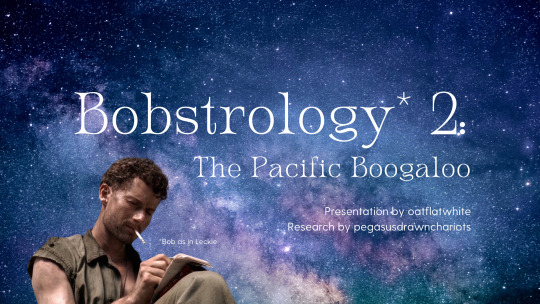


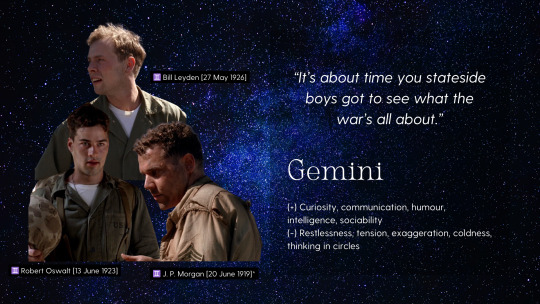
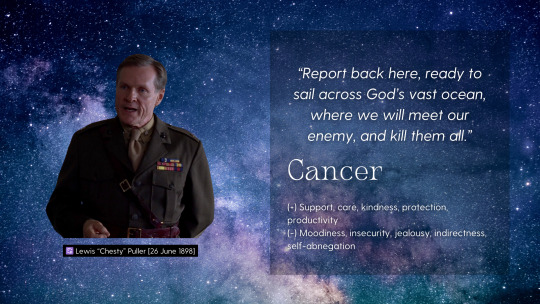
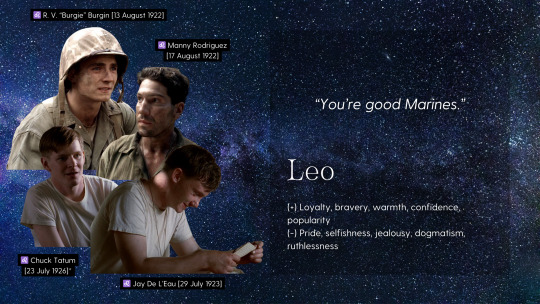
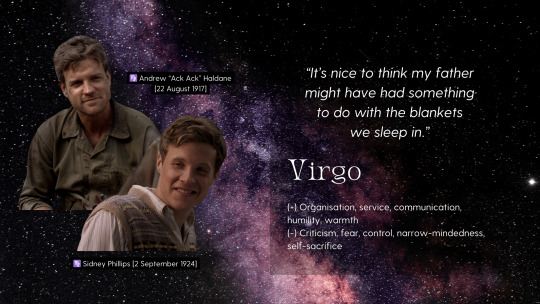

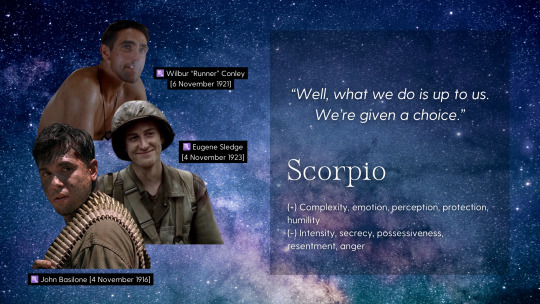
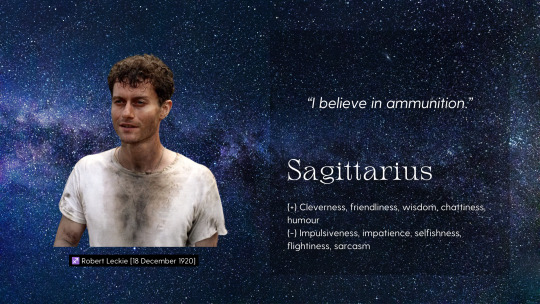
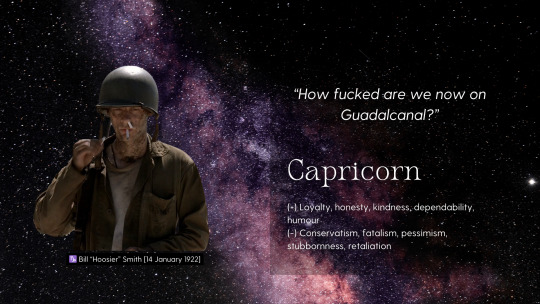
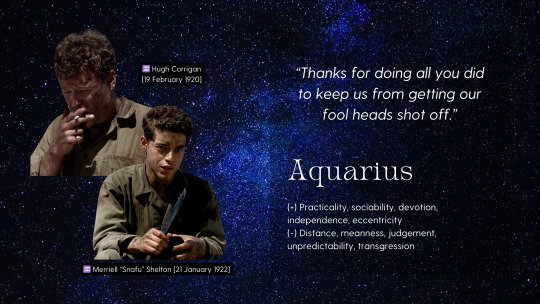


BOBSTROLOGY 2: THE PACIFIC BOOGALOO
Another completely serious presentation by @pegasusdrawnchariots and oatflatwhite
written version under the cut!
♈️ Edward “Hillbilly” Jones – 1 April 1917 ♈️ Elmo “Gunny” Haney – ?? April 1898 * ♉️ Clifford "Steve" Evanson – 25 April 1926 ♊️ Bill Leyden – 27 May 1926 ♊️ Robert Oswalt – 13 June 1923 ♊️ J. P. Morgan – 20 June 1919 * ♋️ Lewis “Chesty” Puller – 26 June 1898 ♌️ Chuck Tatum – 23 July 1926 * ♌️ Jay De L’Eau – 29 July 1923 ♌️ R. V. "Burgie" Burgin – 13 August 1922 ♌️ Manny Rodriguez – 17 August 1922 ♍️ Andrew “Ack Ack” Haldane – 22 August 1917 ♍️ Sidney Phillips – 2 September 1924 ♎️ Vera Keller – 13 October 1923 ♎️ Lew “Chuckler” Juergens – 22 October 1918 ♏️ John Basilone – 4 November 1916 ♏️ Eugene Sledge – 4 November 1923 ♏️ Wilbur “Runner” Conley – 6 November 1921 ♐️ Robert Leckie – 18 December 1920 ♑️ Bill “Hoosier” Smith – 14 January 1922 ♒️ Merriel “Snafu” Shelton – 21 January 1922 ♒️ Hugh Corrigan – 19 February 1920 ♓️ Lena Riggi Basilone – 7 March 1913
2 Aries 1 Taurus 3 Gemini 🥈 1 Cancer 4 Leo 🥇 2 Virgo 2 Libra 3 Scorpio 🥈 1 Sagittarius 1 Capricorn 2 Aquarius 1 Pisces
7 🔥 4 🪨 7 💨 5 💧
6 cardinal 10 fixed 7 mutable
14 masculine 9 feminine
* Gunny Haney's day of birth is not known; we went with Aries on vibes * J. P. Morgan's birthday was taken from The Pacific wiki but we couldn't verify it elsewhere (or whether he was actually a real dude?) * Chuck Tatum is a cusp and we assigned him Leo based on his city of birth if he had been born at noon; also on vibes
** Other characters in The Pacific are based on people from Leckie and Sledge's memoirs, but their names are either changed or they are only referred to by surname and quite unidentifiable, based on my (oatflatwhite's) original search (which was not exhaustive!). Ronnie Gibson and Stella Karamanlis, for example, seem to be based off of real people Leckie encountered during the war, but were not their actual names. Others, like minor officers in both K and H companies, and the doctors Leckie sees, I just couldn't track down. We could locate the birthdays of Sledge's family (brother and parents) but since we couldn't do the same for Leckie and Basilone, we left them off this list. They're two more Scorpios and another Virgo, by the way.
*** And if you've read this far, @pegasusdrawnchariots assigned Stella Leo based on vibes :-)
#the pacific#hbo war#thepacificedit#hbowaredit#bobstrology#liz makes things#robert leckie#eugene sledge#john basilone#et cetera et cetera#phew what an undertaking
89 notes
·
View notes
Text
1912 Diary Entries: Franz Kafka
31 January. Wrote nothing.
25 February. Hold fast to the diary from today on! Write regularly! Don’t surrender! Even if no salvation should come, I want to be worthy of it at every moment.
26 February. Better consciousness of myself.
8 March. Day before yesterday was blamed because of the factory. Then for an hour on the sofa thought about jumping-out-of-the-window.
11 March. Yesterday unendurable.
16 March. Rather be sleepless than live on in this way.
17 March. Today, painfully tired, spent the afternoon on the sofa.
18 March. I was wise, if you like, because I was prepared for death at any moment, but not because I had taken care of everything that was given to me to do, rather because I had done none of it and could not even hope ever to do any of it.
22 March. (The last few days I have been writing down the wrong dates.)
29 March. Delighted with the bathroom. Gradual understanding. The afternoons I spent on my hair.
1 April. For the first time in a week an almost complete failure in writing. Why? Last week too I lived through various moods and kept their influence away from my writing; but I am afraid to write about it.
8 April. Saturday before Easter. Complete knowledge of oneself.
6 May. 11 o’clock. For the first time in a considerable while a complete failure in writing. The feeling of a tried man.
22 May. Yesterday a wonderfully beautiful evening with Max. If I love myself, I love him more.
25 May. Weak tempo, little blood.
1 June. Wrote nothing.
2 June. Wrote almost nothing.
6 June. Without weight, without bones, without body, walked through the streets for two hours considering what I overcame this afternoon while writing.
7 June. Bad. Wrote nothing today. Tomorrow no time.
6 July. Monday. Began a little. Am a little sleepy. Also lost among these entirely strange people.
9 July. Nothing written for so long. Begin tomorrow. Otherwise I shall again get into a prolonged, irresistible dissatisfaction; I am really in it already. The nervous states are beginning. But if I can do something, then I can do it without superstitious precautions.
7 August. Long torment.
8 August. Completed ‘Confidence Trickster’ more or less satisfactorily. With the last strength of a normal state of mind.
9 August. The upset night.
10 August. Wrote nothing.
11 August. Nothing, nothing.
15 August. Wasted day. Spent sleeping and lying down.
16 August. Nothing, either in the office or at home.
30 August. All this time did nothing.
25 September. By force kept myself from writing.
Excerpts from "The diaries of Franz Kafka 1910-1923"
#requested#franz kafka#literature#writeblr#dark academia#spilled ink#writing reference#kafka#writers on tumblr#writing prompt#poets on tumblr#poetry#diary#writing inspiration#creative writing#lit#writing#light academia#quotes#writing resources
63 notes
·
View notes
Photo

Night of the Long Knives
The Night of the Long Knives (aka Blood Purge or Röhm-Putsch) of 30 June 1934 was a purge of the Nazi Sturmabteilung (SA) paramilitary group which continued through 1 and 2 July. Adolf Hitler (1889-1945), wary of the growing power of the SA, embarrassed by its thuggish behaviour now that he was the chancellor of Germany, and in need of the support of the German Army, which saw the SA as a rival, ordered the assassination of the SA leader Ernst Röhm (1887-1934) along with many other key SA commanders and political enemies of the new Nazi regime. Justified as a purge of dangerous plotters against the state, the Night of the Long Knives revealed that the Nazi leadership regarded themselves as above the law.
The SA
Adolf Hitler became the leader of the Munich-based NSDAP (National Socialist German Workers' Party) in 1921. The party was neither socialist nor at all interested in workers, but Hitler had chosen the name to give his ultra-nationalist party as wide an appeal as possible. Known as the Nazi party, it was also vehemently anti-Semitic and against the German establishment. The SA or Sturmabteilung paramilitary group had been formed in 1921 and was given various functions, such as protecting Nazi party meetings, distributing propaganda, intimidating voters, and attacking party rivals or those identified as 'undesirables', like Jewish people. As Hitler had said, "We must struggle with ideas, but if necessary also with fists" (Hite, 116). From 1924, the SA began to wear brown army surplus uniforms, hence their nickname the Brownshirts.
The SA's growing membership in the early 1920s had already put Hitler on the alert. He decided to create his own personal bodyguard, a much smaller but more loyal group called the Stosstrupp-Hitler (Hitler Shock Troop). Nevertheless, the SA was involved in the infamous Beer Hall Putsch or Munich Putsch, the failed Nazi coup in November 1923. After the failure of the putsch, Hitler and his leading associates were found guilty of treason and imprisoned, albeit for what turned out to be short sentences. The immediate fallout of the putsch was a setback as the Nazi party and SA were banned (temporarily), and the Stosstrupp-Hitler was disbanded. However, the publicity of the court case against Hitler and his excellent oratory skills did actually increase interest in both the Nazi cause and the SA. Temporarily called the Frontbann, there was a huge rise in SA membership from 2,000 in 1923 to 30,000 stormtroopers in 1924.
The SA's growth was overseen by its leader Ernst Röhm. A short, stocky, ruthless man, who carried impressive facial scars from wounds sustained in WWI, Röhm had been instrumental in forming the "gymnastics and sports" branch of the Nazi party, which had then morphed into the SA. As one of Hitler's oldest allies, Röhm had also participated in the Beer Hall Putsch.
Continue reading...
41 notes
·
View notes
Text

Illustration for House & Garden, July 1923 1 (Franklin Booth)
232 notes
·
View notes
Text
You like reading fanfics? How about reading about fanfics? 😏
Here’s what I've read so far (or am currently getting through) for my dissertation on fanfiction bookbinding! I'll be updating it as I go until the end of July. If you have any recs to add to the towering pile or any questions/opinions about something on there, I’m all ears!
on fan studies & ficbinding ✔
Alexander, Julia, ‘Making fanfiction beautiful enough for a bookshelf’, The Verge, 9 March 2021 <https://www.theverge.com/22311788/fanfiction-bookbinding-tiktok-diy-star-wars-harry-potter-twitter-fandom> [accessed 12 June 2024]
Buchsbaum, Shira Belén, ‘Binding fan fiction and reexamining book production models’, Transformative Works and Cultures, 37 (2022)
Dym, Brianna, and Casey Fiesler, ‘Ethical and privacy considerations for research using online fandom data’, Transformative Works and Cultures, 33 (2020)
Jenkins, Henry, Textual Pochers: Television Fans and Participatory Culture (New York: Routeledge, 1992)
Jenkins, Henry, ‘Transmedia Storytelling 101’, Pop Junctions, 21 March 2007 <http://henryjenkins.org/2007/03/transmedia_storytelling_101.html#sthash.gSETwxQX.dpuf> [accessed 12 June 2024]
Hellekson, Karen, ‘Making Use Of: The Gift, Commerce, and Fans’, Cinema Journal, 54, no. 3 (2015), 125–131
Kennedy, Kimberly, ‘Fan binding as a method of fan work preservation’, Transformative Works and Cultures, 37 (2022)
Minkel, Elizabeth, ‘Before “Fans,” There Were “Kranks,” “Longhairs,” and “Lions”: How Do Fandom Gain Their Names?’, Atlas Obscura, 30 May 2024 <https://www.atlasobscura.com/articles/fandom-names> [accessed 12 June 2024]
Penley, Constance, Nasa / Trek: Popular Science and Sex in America (London: Verso, 1997)
Price, Ludi, ‘Fanfiction, Self-Publishing, and the Materiality of the Book: A Fan Writer’s Autoethnography’, Humanities, 11, no. 100 (2022), 1–20
Schiller, Melanie, ‘Transmedia Storytelling: New Practices and Audiences’, in Stories: Screen Narrative in the Digital Era, ed. by Ian Christie and Annie van den Oever (Amsterdam: Amsterdam University Press, 2018), 99–107
on folklore, the internet, other background reading ✔
Barthes, Roland, ‘La mort de l’auteur’ in Le Bruissement de la langue: Essais critiques IV (Paris: Éditions du Seuil, 1984)
Blank, Trevor J., Folklore and the Internet: Vernacular Expression in a Digital World (Logan, Utah: Utah State University Press, 2009)
Mauss, Marcel, ‘Essai sur le don. Forme et raison de l’échange dans les sociétés archaïques.’, L’année sociologique, 1923–1924; digital edition by Jean-Marie Tremblay, Les classiques des sciences sociales, 17 February 2002, <http://classiques.uqac.ca/classiques/mauss_marcel/socio_et_anthropo/2_essai_sur_le_don/essai_sur_le_don.html> [accessed 10 June 2024]
McCulloch, Gretchen, Because Internet: Understanding How Language is Changing (Random House, 2019)
Niles, John D., Homo Narrans: The Poetics and Anthropology of Oral Literature (University of Pennsylvania Press: Philadelphia, 1999)
hopefully coming up next (haven't started yet)
A Companion to Media Fandom and Fan Studies, ed. by Paul Booth (Hoboken: John Wiley & Sons, Inc., 2018)
A Fan Studies Primer: Method, Research, Ethics, ed. by Paul Booth and Rebecca Williams (Iowa City: University of Iowa Press, 2021)
Dietz, Laura, ‘Showing the scars: A short case study of de-enhancement of hypertext works for circulation via fan binding or Kindle Direct Publishing’, 34th ACM Conference on Hypertext and Social Media (HT ‘23), September 4–8, 2023, Rome Italy (ACM: New York, 2023)
Fathallah, Judith May, Fanfiction and the Author: How Fanfic Changes Popular Cultural Texts (Amsterdam: Amsterdam University Press, 2017)
Finn, Kavita Mudan, and Jessica McCall, ‘Exit, pursued by a fan: Shakespeare, Fandom, and the Lure of the Alternate Universe’, Critical Survey, 28, no. 2 (2016), 27–38
Hjorth, Larissa et al., eds. The Routledge Companion to Digital Ethnography (New York: Routledge Taylor & Francis Group, 2017)
Jacobs, Naomi, and JSA Lowe, ‘The Design of Printed Fanfiction: A Case Study of Down to Agincourt Fanbinding’, Proceedings from the Document Academy, 9, issue 1, article 5
Jenkins, Henry, Convergence Culture: Where Old and New Media Collide (New York: New York University Press, 2006)
Jenkins, Henry, Spreadable Media: Creating Value and Meaning In A Networked Culture (New York: New York University Press, 2013)
Kennedy, Kimberly, and Shira Buchsbaum, ‘Reframing Monetization: Compensatory Practices and Generating a Hybrid Economy in Fanbinding Commissions’, Humanities, 11, no. 67 (2022), 1–18
Kirby, Abby, ‘Examining Collaborative Fanfiction: New Practices in Hyperdiegesis and Poaching’, Humanities, 11, no. 87 (2002), 1–9
Kustritz, Anne, Identity, Community, and Sexuality in Slash Fan Fiction (New Work: Routeledge, 2024)
Lamerichs, Nicolle, Productive Fandom: Intermediality and Affecive Reception in Fan Cultures, (Amsterdam: Amsterdam Universtiy Press, 2018)
Popova, Milena, ‘Follow the trope: A digital (auto)ethnography for fan studies’, Transformative Works and Cultures, 33 (2020)
Rosenblatt, Betsy, and Rebecca Tushnet, ‘Transformative Works: Young Women’s Voices on Fandom and Fair Use’, in eGirls, eCitizens: Putting Technology, Theory and Policy into Dialogue with Girls’ and Young Women’s Voices, ed. by Jane Bailey and Valerie Steeves
Soller, Bettina, ‘Filing off the Serial Numbers: Fanfiction and its Adaptation to the Book Market’, in Adaptation in the Age of Media Convergence, ed. by Johannes Fehrle, Werner Schäfke-Zell (Amsterdam: Amsterdam University Press, 2019), 58–85
#fanbinding dissertation#fanbinding lit#bibliography#dissertation#reading list#gradblr#study blog#research#fanfiction#bookbinding#fanbinding#ficbinding#fanfic#ethnology#folklore#currently reading
45 notes
·
View notes
Text
Life’s splendor forever lies in wait about each one of us in all its fullness, but veiled from view, deep down, invisible, far off. It is there, though, not hostile, not reluctant, not deaf. If you summon it by the right word, by its right name, it will come.
— Franz Kafka, Diaries of Franz Kafka 1914-1923 (Lumen; 001 edition, July 26, 2022) Originally published January 1, 1974. (via The Vale of Soul Making)
53 notes
·
View notes
Text
Movie Musical Divas Tournament: Round 1


Glynis Johns (1923-2024): Mary Poppins (1964) as Winnifred Banks | Mad About Men (1954) as Caroline Trewella
"We just lost Glynis Johns this year at the ripe old age of 100. She was such an icon and even though she didn't do many musicals, her stage work was unforgettable. "Sister Suffragette" was written specifically for her as a consolation for the whole Mary Poppins misunderstanding and the Sherman brothers knocked that out in a single lunch hour. " - anonymous
Julie Andrews (1935- ): Mary Poppins in Mary Poppins (1964) | Maria in The Sound of Music (1965) | Victoria Grant in Victor/Victoria (1982) | Millie Dillmount in Thoroughly Modern Millie (1967)
"The QUEEN of the movie musical. Started in so many long lasting favorites. Dressed in drag in Victor/Victoria, thanked the casting director of My Fair Lady in her Oscar Acceptance speech for snubbing her for the role so that she could win an Oscar instead. The voice of so many people’s childhoods and genuinely such an amazing person. Look up the story about her Tony nomination!" - @kingscatt
This is Round 1 of the Movie Musical Divas tournament. Additional polls in this round may be found by searching #mmround1, or by clicking the link below. Add your propaganda and support by reblogging this post.
ADDITIONAL PROPAGANDA AND MEDIA UNDER CUT: ALL POLLS HERE
Glynis Johns:



youtube
Photos and video submitted by: anonymous
Julie Andrews:
"The woman so talented Walt Disney was willing to wait. Saying Julie Andrews is immensely talented is about as non-controversial as it gets, but the level of talent she possesses is almost too much to process. Seriously, the way she effortlessly blends singing, dancing, and acting to create nuances in her performances is beyond the beyond. It’s cliche, but she really is practically perfect in every way." - anonymous




youtube
youtube
Photos submitted by: @funnygirlthatbelle | Video submitted by: anonymous | Video submitted by: @mygreatadventurehasbegun
28 notes
·
View notes
Text
Rewind the Tape —Episode 3
Art of the episode
Just like we did for the pilot and for episode two, we took note of the art shown and mentioned in the third episode while we rewatched it. Did we miss any? Can you help us put a name to the unidentified ones? Do you have any thoughts about how these references could be interpreted?

On the Origin of Species*
Charles Darwin, 1859
* Not exactly art... ...and not exactly confirmed, but given the time, the subject of their conversation, and Lestat's "...this naturalist that fogs your mind" remark, this seems the most likely attribution for the book Louis is reading during the opening scene.

Darktown Strutters' Ball
Shelton Brooks, 1917
The song Antoinette is first singing was published that same year, and you can hear it performed by The Platters here.
Minuet in G
Christian Petzold, circa 1725
As pointed by @cardassiangoodreads in this post, the song Lestat first plays before he starts improvising is Petzold's Minuet in G, often falsely attributed to Johann Sebastian Bach.
Wolverine Blues
Jelly Roll Morton, 1923
While the scene in which Lestat improvises the melody happens in 1917, Morton would go on to record and release the song in Indiana in 1923.

Slave Auction
Jean-Michael Basquiat, 1982

Our very first look at Basquiat's Slave Auction comes in the third episode, though it will be the backdrop of most of the sixth. While some elements, like the crown of thorns, lend themselves to varied interpretations, it's clear this collage shows a boat (golden for money, perhaps) crossing a blue expanse, and the faces of the slaves being transported.
Mother Daughter and Twins 1
Rahmon Olugunna, undated

Rahmon Olugunna, born in Osogbo in 1975, is a member of the Oshogbo school of artists in Nigeria. His work represents Yoruban mythology as well as modern Nigerian life. He is represented by New Orleans curator Katie Koch. [Identified by @vfevermillion.]
Untitled ceramic totems
Julie Silvers, undated

Each unique totem is made by New Orleans native Julie Silvers, and they are distributed by New Orleans store Villa Vici. Two can be seen in the sitting room. [Identified by @vfevermillion.]
Javelina
Bryan Cunningham, undated
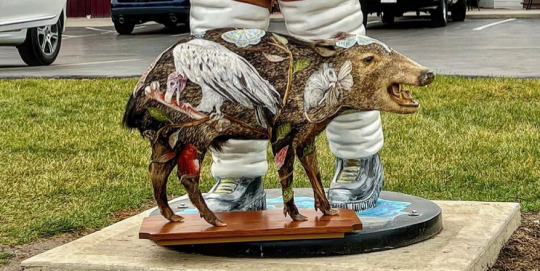
By "Junkyard Alchemist" Bryan Cunningham, who posted about it here. [Found by @iwtvdramacd18.]
In the same shot we can see an unidentified painting, maybe of a man's profile. Perhaps you can place it?

Untitled photo of loading docks in St. Paul, Minnesota
Bradley Olson, 2015 (Alamy Stock Photo)
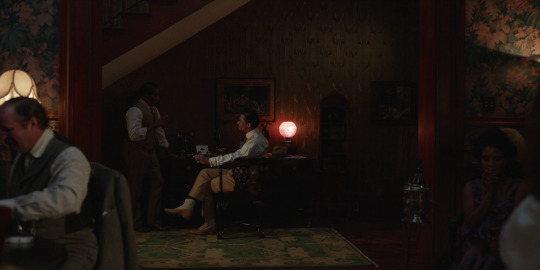

Forty-two Kids and Cliff Dwellers
George Bellows, 1907 and 1913 respectively
Several Bellows pieces have been featured around Rue Royale already, in episodes one and two. [Identified by @nicodelenfent, here.]

Am I Blue?
Harry Akst and Grant Clarke, 1929 [Identified by @ouizaya.]
The song that Antoinette sings when Jonah first walks into the Azalea is actually an anachronism. Maybe a bit of commentary from Louis, as this post suggests.
Nocturnes, Op. 55: No. 1 in F minor. Andante
Frederic Chopin, 1842-1844
This is the song that plays during Jonah and Louis's escapade to the Bayou.

Roman Bacchanal
Vasily (Wilhelm) Alexandrovich Kotarbiński, 1898
Kotarbiński was a Polish artist and painter of historical and fantastical subjects, and co-founder of the Society of Kyiv Painters. [Identified by @nicodelenfent.]
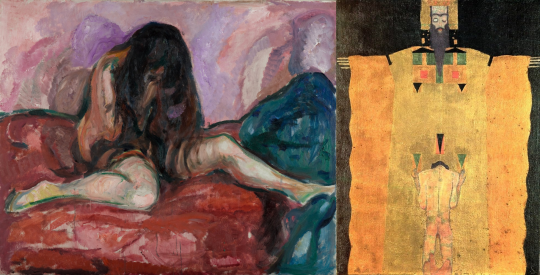

Weeping Nude
Edvard Munch, 1913
Young Man kneeling before God the Father
Egon Schiele, 1909
Two more artists we've seen already, in episodes one and two.
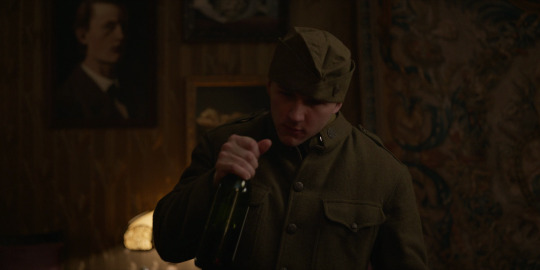

Self-Portrait
Edvard Munch, 1881-1882
Bouquet in a theater box
Pierre-Auguste Renoir, 1871
While we have seen Munch's work already, this is the first Renoir featured. He was a French artist and a leading figure in the development of the Impressionist style. [Identified by @nicodelenfent.]

Church in Stein on the Danube
Egon Schiele, 1913 [Identified by @nicodelenfent, here.]
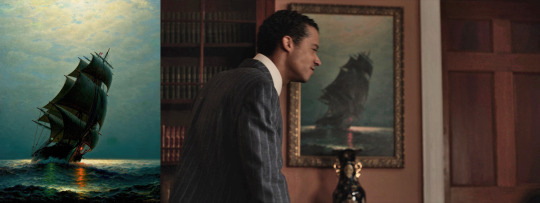
Ship in the Night
James Gale Tyler, c. 1870 [Identified by @vfevermillion.]
Tyler was a New York born marine painter, considered a self-taught artist.
If you spot or put a name to any other references, let us know if you'd like us to add them with credit to the post!
This week, we are rewatching and discussing Episode 4, …The Ruthless Pursuit of Blood with All a Child's Demanding. We can't wait to hear your thoughts!
And, if you're just getting caught up, learn all about our group rewatch here ►
#louis de pointe du lac#daniel molloy#lestat de lioncourt#vampterview#interview with the vampire#iwtv#amc interview with the vampire#interview with the vampire amc#amc iwtv#iwtv amc#IWTVfanevents#rewind the tape#is my very nature that of a devil#analysis and meta#art of the episode
49 notes
·
View notes
Text

July 1, 1925 Journals of Anais Nin 1923-1927 [volume 3]
#anais nin#literature#july#july 1#words#quotes#academia#dark academia#quote#lit#books#books and libraries#reading#quote of the day#bookworm#book quotes#prose#booklr#bibliophile#excerpt#light academia
438 notes
·
View notes
Text
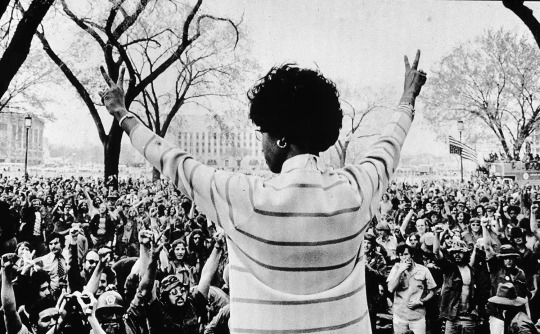
Black women have made important contributions to the United States throughout its history. However, they are not always recognized for their efforts, with some remaining anonymous and others becoming famous for their achievements. In the face of gender and racial bias, Black women have broken barriers, challenged the status quo, and fought for equal rights for all. The accomplishments of Black female historical figures in politics, science, the arts, and more continue to impact society.
Marian Anderson (Feb. 27, 1897–April 8, 1993)

Underwood Archives / Getty Images
Contralto Marian Anderson is considered one of the most important singers of the 20th century. Known for her impressive three-octave vocal range, she performed widely in the U.S. and Europe, beginning in the 1920s. She was invited to perform at the White House for President Franklin Roosevelt and First Lady Eleanor Roosevelt in 1936, the first African American so honored. Three years later, after the Daughters of the American Revolution refused to allow Anderson to sing at a Washington, D.C. gathering, the Roosevelts invited her to perform on the steps of the Lincon Memorial.
Anderson continued to sing professionally until the 1960s when she became involved in politics and civil rights issues. Among her many honors, Anderson received the Presidential Medal of Freedom in 1963 and a Grammy Lifetime Achievement Award in 1991.
Mary McLeod Bethune (July 10, 1875–May 18, 1955)
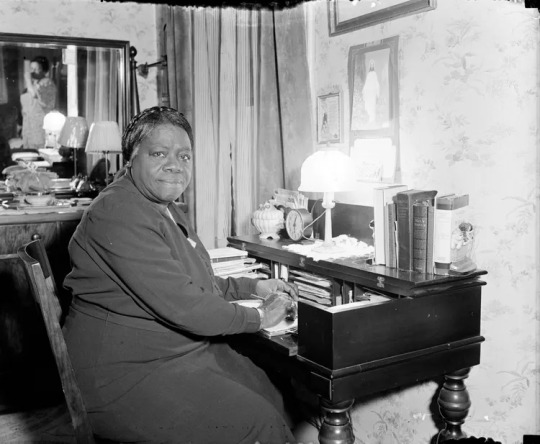
PhotoQuest / Getty Images
Mary McLeod Bethune was an African American educator and civil rights leader best known for her work co-founding the Bethune-Cookman University in Florida. Born into a sharecropping family in South Carolina, the young Bethune had a zest for learning from her earliest days. After stints teaching in Georgia, she and her husband moved to Florida and eventually settled in Jacksonville. There, she founded the Daytona Normal and Industrial Institute in 1904 to provide education for Black girls. It merged with the Cookman Institute for Men in 1923, and Bethune served as president for the next two decades.
A passionate philanthropist, Bethune also led civil rights organizations and advised Presidents Calvin Coolidge, Herbert Hoover, and Franklin Roosevelt on African American issues. In addition, President Harry Truman invited her to attend the founding convention of the United Nations; she was the only African American delegate to attend.
Shirley Chisholm (Nov. 30, 1924–Jan. 1, 2005)
Don Hogan Charles / Getty Images
Shirley Chisholm is best known for her 1972 bid to win the Democratic presidential nomination; she was the first Black woman to make this attempt in a major political party. However, she had been active in state and national politics for more than a decade and had represented parts of Brooklyn in the New York State Assembly from 1965 to 1968. She became the first Black woman to serve in Congress in 1968. During her tenure, she co-founded the Congressional Black Caucus. Chisholm left Washington in 1983 and devoted the rest of her life to civil rights and women's issues.
Althea Gibson (Aug. 25, 1927–Sept. 28, 2003)
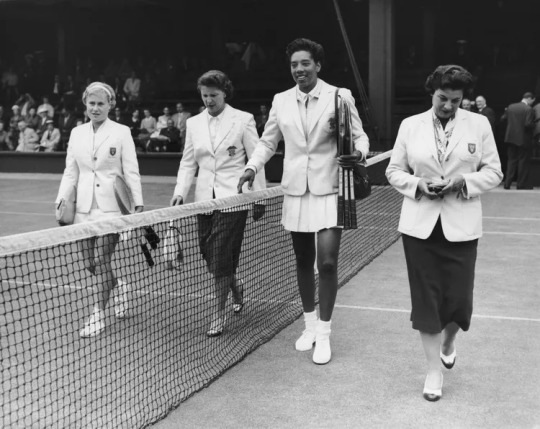
Reg Speller / Getty Images
Althea Gibson started playing tennis as a child in New York City, winning her first tennis tournament at age 15. She dominated the American Tennis Association circuit, reserved for Black players, for more than a decade. In 1950, Gibson broke the tennis color barrier at Forest Hills Country Club (site of the U.S. Open); the following year, she became the first African American to play at Wimbledon in Great Britain. Gibson continued to excel at the sport, winning both amateur and professional titles through the early 1960s.
Dorothy Height (March 24, 1912–April 20, 2010)
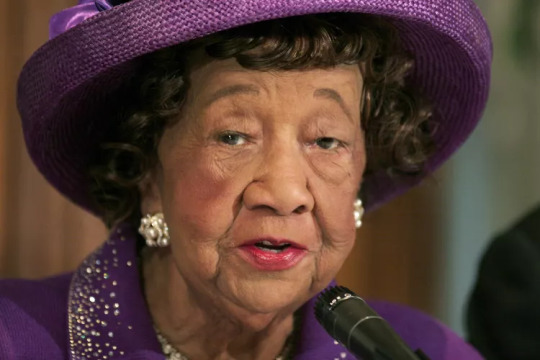
Chip Somodevilla / Getty Images
Dorothy Height has been described as the godmother of the women's movement because of her work for gender equality. For four decades, she led the National Council of Negro Women (NCNW )and was a leading figure in the 1963 March on Washington. Height began her career as an educator in New York City, where her work caught the attention of Eleanor Roosevelt. Beginning in 1957, she led the NCNW and also advised the Young Women's Christian Association (YWCA). She received the Presidential Medal of Freedom in 1994.
Rosa Parks (Feb. 4, 1913–Oct. 24, 2005)
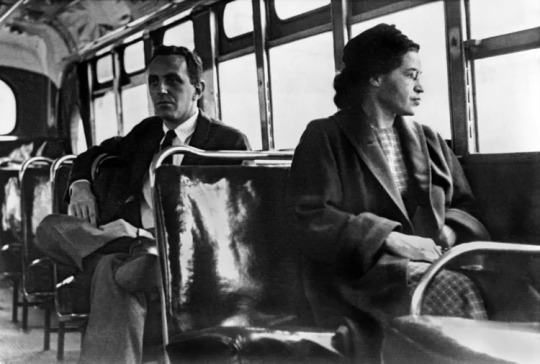
Underwood Archives / Getty Images
Rosa Parks became active in the Alabama civil rights movement after marrying activist Raymond Parks in 1932. She joined the Montgomery, Alabama, chapter of the National Association for the Advancement of Colored People (NAACP) in 1943 and was involved in much of the planning that went into the famous bus boycott that began the following decade. Parks is best known for her December 1, 1955, arrest for refusing to give up her bus seat to a White rider. That incident sparked the 381-day Montgomery Bus Boycott, which eventually desegregated that city's public transit. Parks and her family moved to Detroit in 1957, and she remained active in civil rights until her death.
Augusta Savage (Feb. 29, 1892–March 26, 1962)
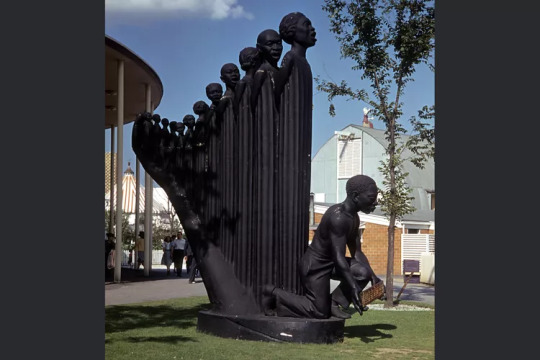
Archive Photos / Sherman Oaks Antique Mall / Getty Images
Augusta Savage displayed an artistic aptitude from her youngest days. Encouraged to develop her talent, she enrolled in New York City's Cooper Union to study art. She earned her first commission, a sculpture of civil rights leader W.E.B. Du Bois, from the New York library system in 1921, and several other commissions followed. Despite meager resources, she continued working through the Great Depression, making sculptures of several notable Black people, including Frederick Douglass and W. C. Handy. Her best-known work, "The Harp," was featured at the 1939 World's Fair in New York, but it was destroyed after the fair ended.
Harriet Tubman (1822–March 20, 1913)

Library of Congress
Enslaved from birth in Maryland, Harriet Tubman escaped to freedom in 1849. The year after she arrived in Philadelphia, Tubman returned to Maryland to free her family members. Over the next 12 years, she returned nearly 20 times, helping more than 300 enslaved Black people escape bondage by ushering them along the Underground Railroad. The "railroad" was the nickname for a secret route that enslaved Black people used to flee the South for anti-slavery states in the North and to Canada. During the Civil War, Tubman worked as a nurse, a scout, and a spy for Union forces. After the war, she worked to establish schools for formerly enslaved people in South Carolina. In her later years, Tubman also became involved in women's rights causes.
Phillis Wheatley (May 8, 1753–Dec. 5, 1784)

Culture Club/Hulton Archive/Getty Images
Born in Africa, Phillis Wheatley came to the U.S. at age 8, when she was captured and sold into enslavement. John Wheatley, the Boston man who enslaved her, was impressed by Phillis' intellect and interest in learning, and he and his wife taught her to read and write. The Wheatleys allowed Phillis time to pursue her studies, which led her to develop an interest in poetry writing. A poem she published in 1767 earned her much acclaim. Six years later, her first volume of poems was published in London, and she became known in both the U.S. and the United Kingdom. The Revolutionary War disrupted Wheatley's writing, however, and she was not widely published after it ended.
Charlotte Ray (Jan. 13, 1850–Jan. 4, 1911)
Charlotte Ray has the distinction of being the first African American woman lawyer in the United States and the first woman admitted to the bar in the District of Columbia. Her father, active in New York City's Black community, made sure his young daughter was well educated; she received her law degree from Howard University in 1872 and was admitted to the Washington, D.C., bar shortly afterward. Both her race and gender proved to be obstacles in her professional career, and she eventually became a teacher in New York City instead.
#10 of the Most Important Black Women in U.S. History#Black Women#Black Women Matter#Black Lives Matter#us history
217 notes
·
View notes
Text
Röhm was the co-founder and leader of the Sturmabteilung (SA), the Nazi Party's original paramilitary wing, which played a significant role in Adolf Hitler's rise to power. He served as chief of the SA from 1931 until his murder in 1934 during the Night of the Long Knives.
In 1923, he took part in Hitler's failed Beer Hall Putsch to seize governmental power in Munich and was given a suspended prison sentence. After a stint as a Reichstag deputy, Röhm broke with Hitler in 1925 over the future direction of the Nazi Party. He resigned from all positions and emigrated to Bolivia, where he served as an advisor to the Bolivian Army.
In 1930, at Hitler's request, Röhm returned to Germany and was officially appointed chief of staff of the SA in 1931. He reorganised the SA, which numbered over a million members, and continued its campaign of political violence against communists, rival political parties, Jews and other groups deemed hostile to the Nazi agenda. At the same time, opposition to Röhm intensified as his homosexuality gradually became public knowledge.
Throughout 1933 and 1934, Röhm's rhetoric became increasingly radical as he called for a "second revolution" that would transform German society, alarming Hitler's powerful industrial allies. He also demanded more power for the SA, which the Reichswehr saw as a growing threat to its position. Hitler came to see his long-time ally as a rival and liability, and made the decision to eliminate him with the assistance of SS leaders Heinrich Himmler and Reinhard Heydrich.
On 30 June 1934, the entire SA leadership were purged by the SS during an event known as the Night of the Long Knives. Röhm was taken to Stadelheim Prison and shot on 1 July.

#reichblr#wwii#wwii era#ww2 history#ww2#ww2 germany#wwii germany#3rd reich#heydrich#reinhard heydrich#himmler#heinrich himmler#ernst rohm#ernst röhm
8 notes
·
View notes
Text














BOBSTROLOGY
A completely serious presentation by @pegasusdrawnchariots and oatflatwhite
written version under the cut!
♈️Patrick O’Keefe [April 3 1926] ♈️Robert Sink [April 3 1905] ♈️John Julian [5 April 1924] ♈️Renée Lemaire [10 April 1914] ♈️James Miller [11 April 1924] ♈️Walter “Smokey” Gordon [April 15 1920] ♉️~Ronald Speirs [April 20 1920] ♉️Alton More [April 22 1920] ♉️Henry Jones [27 April 1924] ♉️Edward “Babe” Heffron [May 16 1923] ♉️John Martin [May 12 1922] ♉️Joseph Liebgott [May 17 1915] ♉️Norman Dike [May 19 1918] ♉️William Guarnere [April 28 1923] ♊️David Webster [June 2 1922] ♊️George Luz [June 17 1921] ♊️Roy Cobb [June 18 1914] ♋️Frederick “Moose” Heyliger [June 23 1916] ♋️Albert Blithe [June 25 1923] ♋️Donald Hoobler [28 June 1922] ♋️Thomas Meehan [8 July 1921] ♋️John Janovec [9 July 1925] ♋️Robert “Popeye” Wynn [July 10 1921] ♋️James "Moe" Alley [July 20 1922] ♌️~Burton “Pat” Christenson [July 23 1922] ♌️Eugene Jackson [29 July 1922] ♌️Donald Malarkey [July 31 1921] ♌️Edward Tipper [3 August 1921] ♍️Floyd Talbert [August 26 1923] ♍️Alex Penkala [August 30 1922] ♍️William Dukeman [3 September 1921] ♎️Eugene Roe [October 17 1922] ♎️Harry Welsh [September 27 1918] ♎️Lewis Nixon [September 30 1918] ♎️Ralph Spina [October 5 1919] ♎️Thomas Peacock [October 9 1923] ♏️Denver “Bull” Randleman [November 20 1920] ♑️Lynn “Buck” Compton [December 31 1921] ♑️Antonio Garcia [January 17 1925] ♒️Richard "Dick" Winters [January 21 1918] ♒️Herbert Sobel [January 26 1912] ♒️Carwood Lipton [January 30 1920] ♒️Warren “Skip” Muck [January 31 1922] ♓️Lester Hashey [23 February 1925] ♓️Charles “Chuck” Grant [1 March 1922] ♓️Robert Strayer [March 2 1912] ♓️Wayne “Skinny” Sisk [March 4 1922] ♓️Frank Perconte [March 10 1917] ♓️Darrell “Shifty” Powers [March 13 1923] ♓️Joseph Toye [March 14 1919]
6 Aries 🥉 8 Taurus 🥇 3 Gemini 7 Cancer 🥈 4 Leo 3 Virgo 5 Libra 1 Scorpio 0 Sagittarius 🥄 2 Capricorn 4 Aquarius 7 Pisces 🥈
10 🔥 13 🪨 12 💨 15 💧
20 cardinal 17 fixed 13 mutable
22 masculine 28 feminine
#band of brothers#hbo war#bobedit#hbowaredit#bobstrology#astrology#liz makes things#disclaimer: our interpretation is ironclad. we alone decide the law. argue w the wall.#< we say as an aries and scorpio with renee and bull in our corners <3
217 notes
·
View notes